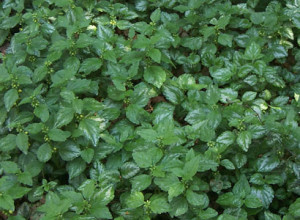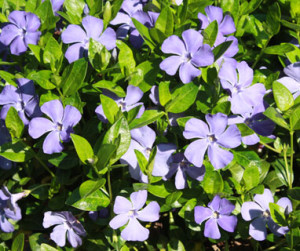Ground Covers – Winter Care and Fertilizing
 Non-evergreen:
Non-evergreen:
Beds should be cleaned out in early spring before any new growth develops. Careful raking will do a fine job, depending on the type of plants.
Newly planted groundcovers should receive a layer of evergreen boughs put down after the ground has frozen. This will help keep the ground frozen more consistently and this reducing the chances of frost pushing the plants out of the ground. Boughs should be taken up in early April.
By fertilizing young groundcover plants you will increase both the size and the amount of flowers on the plant. Liquid fertilizers are most often used on groundcovers because it is much easier to use than granular. Using liquid fertilizer ( Miracle Gro20-20-20) is done the same way as watering, but with fertilizer mixed in. It should be done 3 or 4 times per year starting in late April and stopping in mid July. Granular types are worked into the soil around the plants at a rate of 2 lbs or 2 pints per 100 sq. ft. of planting bed. This is best done in early spring before new growth and only done one time per year. Multi Purpose 10-10-10 Fertilizer by Greenview works well.
Evergreen: 
Beds should be cleaned out in early spring to remove trash and leaves from the plants, this done mainly by hand or with a leaf blower. Dead or damaged sections should be removed at this time.
Pruning Vinca; After the plants has finished flowering, lightly tip back the plants with a hand pruner or hand shears.
Pruning Euonymus; In early spring shear back the tops (no more than 1/3) to increase density and control height. More pruning can be done through growing the season until mid summer.
Pruning Ivy Baltic/English; In early spring, prune back ends and tips to increase density and control height. Shearing can also be done on more established plants if needed. More pruning can be done through the growing, season until mid summer.
Pruning Pachysandra; This plant does not need yearly pruning, however, it may need a renewal pruning ever 3 to 6 years. This done as the individual plants get rather long and stringy. All of the plants are cut down to an inch in height. This is done in early spring and care should be taken to cut the long stems that grow along the ground, as well as those growing straight up. The bed should be raked out to remove debris. The plant will start slow but will fill in fairly quickly. Fertilizing is critical both the year before and the year of the renewal pruning.
Newly planted groundcovers should receive a layer of evergreen boughs put down after the ground has frozen. This will help keep the ground frozen more consistently and this reducing the chances of frost pushing the plants out of the ground. The evergreen groundcovers are also susceptible to winter desiccation. The boughs also will help to control this by keeping the sun and wind away from the plant. Boughs should be taken up in early April.
By fertilizing young groundcover plants you will increase both the size and density. Liquid fertilizers are most often used on groundcovers because they are much easier to use than granular. Using liquid fertilizer ( Miracle Gro Acid 30-10-10) is done the same way as watering, but with fertilizer mixed in. It should be done 3 or 4 times per year starting in late April and stopping in mid July. Granular types are worked into the soil around the plants at a rate of 2 lbs or 2 pints per 100 sq. ft. of planting bed. This is best done in early spring before new growth and only done one time per year. Multi Purpose 10-10-10 Fertilizer work well.
